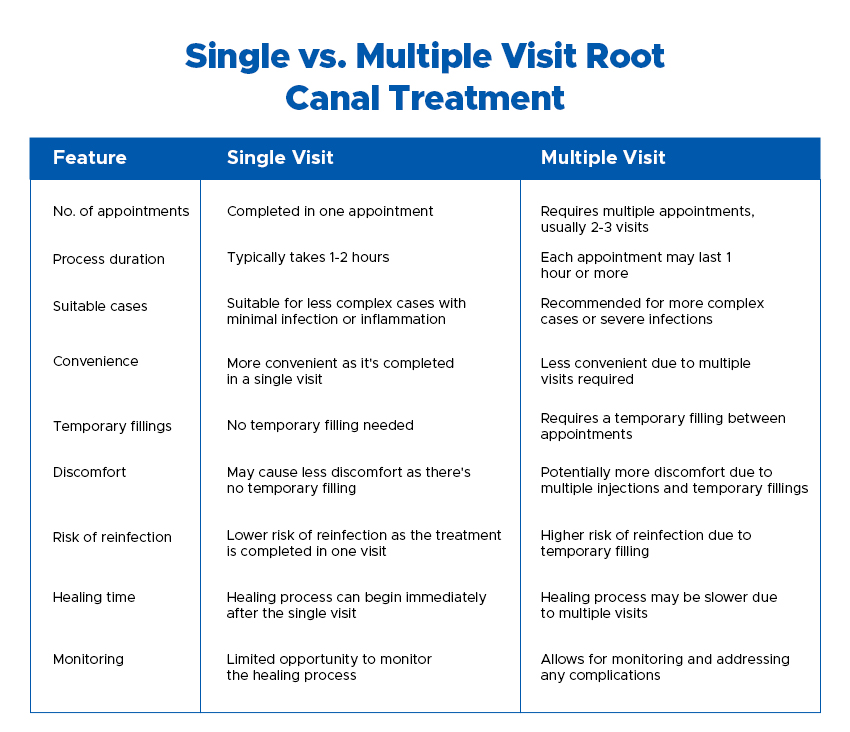Delhi Address:
36-A, Pocket 2, Sector 6, Behind Sector 6 Market, Dwarka, Delhi
Gurugram Address:
R2 136 M3M 65th Avenue Sector 65, Golf course extension road. Gurgaon Haryana 122101

Root canal treatment is a common dental procedure that aims to save a severely decayed or infected tooth by removing the damaged or diseased pulp. Depending on the complexity of the case and the individual circumstances, this treatment can be performed in either a single visit or multiple visits. Understanding the differences between these two approaches is crucial for patients to make an informed decision about their dental care.
In this blog, let us know more about Single Vs Multiple Visit Root Canals and get better insights.
Root canal treatment is a dental procedure that involves removing the infected or damaged pulp (soft inner tissue) from inside the tooth. This pulp consists of nerves, blood vessels, and connective tissue. When the pulp becomes infected or inflamed due to deep decay, repeated dental procedures, or a crack or chip in the tooth, it needs to be removed to save the tooth and prevent further infection or pain.
The root canal procedure involves creating an opening in the top of the tooth, removing the infected or damaged pulp, cleaning and disinfecting the inside of the tooth, and then filling and sealing the empty space. This procedure is typically performed by a dentist or an endodontist (a specialist in root canal treatment).
Root canal treatment can be performed either during a single visit or multiple visits, depending on various factors. Let's understand the differences between the two approaches.

As the name suggests, a single-visit root canal treatment is completed in one appointment. This approach is often preferred when the infection or inflammation is minimal and the tooth is easily accessible. The entire procedure, including cleaning, shaping, and filling the root canals, is performed in a single visit.
The main advantages of a single-visit root canal treatment are:
It saves time and eliminates the need for multiple appointments, which can be particularly beneficial for patients with busy schedules or those who live far from the dental office.
With a single visit, there is no need for temporary fillings or multiple injections, which can minimise discomfort and the risk of reinfection.
Since the entire procedure is completed in one visit, the healing process can begin immediately, potentially leading to a faster recovery time.
In some cases, a root canal treatment may require multiple visits. This approach is typically chosen when the infection or inflammation is severe, the root canal system is complex, or there are other complicating factors.
During the first visit, the dentist or endodontist will clean and shape the root canals. A temporary filling is then placed to seal the tooth until the next appointment. In subsequent visits, the dentist will continue cleaning and disinfecting the root canals and then fill and seal them permanently.
The main advantages of a multiple-visit root canal treatment are:
Multiple visits allow for a more thorough cleaning and disinfection of the root canal system, particularly in complex cases or when the infection is severe.
By breaking the treatment into multiple steps, the dentist can monitor the healing process and address any potential complications that may arise.
Some patients may find it more comfortable to have the procedure divided into multiple visits, as it can reduce the duration of each appointment and minimise discomfort.
The choice between a single-visit or multiple-visit root canal treatment depends on several factors, including the severity of the infection, the complexity of the root canal system, the overall condition of the tooth, and the patient's preference.
Your dentist or endodontist at the best dental hospital in Dwarka will evaluate your situation and discuss the most appropriate treatment plan with you. They will consider factors such as the potential for discomfort, the risk of complications, and your personal circumstances to determine the best approach for your specific case.
Regardless of whether you opt for a single-visit or multiple-visit root canal treatment, the goal is to save your natural tooth and prevent further infection or complications. By following your dentist's recommendations and adhering to proper oral hygiene practices, you can increase the chances of a successful root canal treatment and maintain good oral health.
Choosing between a single visit or multiple visit root canal treatment ultimately depends on your specific situation and the recommendation of your dentist or endodontist. While a single visit may offer convenience and faster recovery, a multiple-visit approach may be more suitable for complex cases or severe infections. Regardless of the approach, the primary goal is to save your natural tooth and prevent further complications.
If you are looking for the best dentist in Dwarka Sector 6, visit Vital Dental Care. Our experts are known for providing root canal treatment in Delhi, which allows you to get your desired smile without any problems. Book an appointment today to know more.
You may need a root canal treatment if you experience persistent pain or sensitivity in a tooth, swelling or tenderness in the gums around a tooth, discolouration of a tooth, or if you have an abscess (pus-filled pocket) near the root of a tooth. These symptoms can indicate that the pulp inside the tooth is infected or inflamed, which requires a root canal procedure to save the tooth.
Root canal treatments are often associated with pain, but the procedure itself is not painful. Your dentist will numb the area around the affected tooth with local anaesthesia before starting the treatment. You may experience some discomfort or mild soreness after the procedure, but this can be managed with over-the-counter pain medication.
If you don't get a root canal treatment when needed, the infection or inflammation in the pulp can spread to the surrounding tissues and bones. This can lead to severe pain, swelling, and the formation of an abscess. In severe cases, the infection can even spread to other parts of the body. If left untreated, the tooth may eventually need to be extracted.
The duration of a root canal treatment can vary depending on the approach chosen (single visit or multiple visits) and the complexity of the case. A single-visit root canal treatment typically takes 1-2 hours, while a multiple-visit treatment may require several appointments, each lasting around an hour or more.
After a root canal treatment, it's recommended to avoid chewing or biting on the treated tooth until it has been permanently restored with a filling or crown. You can eat and drink as normal, but it's best to stick to soft or liquid foods for the first few days to allow the area to heal. Your dentist will provide specific instructions on what to eat and what to avoid based on your individual case.

